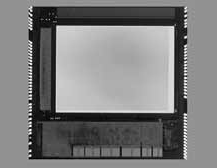 |
||
|
||
| ||
Sigma Launches The SD14 Digital SLR Philips To Protect MRAM From Hackers Toshiba Expands CMOS Image Sensor Lineup Compal And Fortemedia Launch First Notebook With Small Array Microphone DALSA Image Sensors Power New Seitz Panoramic Cameras Sigma Launches The SD14 Digital SLR Sigma Corporation announced the launch of the new Sigma SD14 Digital SLR camera powered by the 14-megapixel Foveon X3 direct-image-sensor. The SD14 Digital SLR camera features four JPEG recording modes, large and bright pentaprism viewfinder with 98% coverage, a built-in flash with a Guide Number of 11, 5-point AF system, a large 2.5” 150,000 pixel resolution LCD monitor. The durable shutter mechanism has over 100,000 cycle life.  The 14-megapixel Foveon X3 Pro 14M image sensor is sized 20.7 x 13.8 mm and has three layers, 2652x1768 pixels each. Maximum image resolution is 2640x1760 pixels or 4608x3072 pixels when interpolated.  Speaking of price, there's no official information, but rumour has it that the camera will cost about $2,000. Source: Sigma Corporation
Philips To Protect MRAM From Hackers Magnetic Random Access Memory (MRAM) was developed by Honeywell and Motorola as a successor to flash memory. Now Philips has plans to make it hacker-proof. MRAM stores data by reading and writing data magnetically to a stack of thin film layers. If, however, a hacker opens the chip, they can easily read sensitive data from the layers directly. This could be a problem if an MRAM chip is used for high-security applications, like storing passwords or cryptographic keys. The thin-film magnets in Philips' tamper-proof chip will be wrapped in a soft metal sheet and then topped with another thin-film magnet. While the wrapper remains intact the soft metal acts as a "keeper", gathering flux from the permanent magnet into a closed loop and keeping it away from the MRAM stack. But if someone attempts to break through the metal wrap to access the MRAM layers, the keeper becomes ineffective. Flux then breaks out and immediately erases the magnetic data stored in the MRAM chip. The beauty of the system is that it is passive. So, disconnecting power to the chip does not keep the permanent magnet from doing its job. Here's the full self-destructing memory patent application. Source: NewScientistTech
Toshiba Expands CMOS Image Sensor Lineup Toshiba Corporation today announced that it has upgraded and expanded Dynastron, its line-up of complementary metal oxide semiconductor (CMOS) image sensors for integration in mobile handsets. Two new models, the 3.2 megapixel ET8EE6-AS and 2.0 megapixel ET8EF2-AS, bring advances to cellular phones and other camera-enabled mobile devices.  Both new image sensors achieve advances in miniaturization while maintaining high resolution. With the ET8EE6-AS Toshiba reduces a 3.2 megapixel image sensor to a 1/3.2 optical format, surpassing the company's previous 1/2.6-inch format size. ET8EF2-AS achieves a 2.0 megapixel count in a 1/4-inch optical format. Underlying these advances are a marked reduction in pixel pitch, from 2.7 to 2.2 microns, combined with retention of a pixel size capable of recording high-resolution images. The new sensors also offers low power consumption, smearless imaging and high-speed operation, all essential requirements for personal mobile equipment, including camera phones and personal media centers. ET8EF2-AS also integrates an image signal processor (ISP), providing customers with the essential components for easily configuring a digital camera system. Source: Toshiba Corporation
Compal And Fortemedia Launch First Notebook With Small Array Microphone Fortemedia and Compal Electronics announced the 1st production ready mainstream notebook integrating Fortemedia’s patented Small Array Microphone (SAM) technology at the Intel Developer Forum 2006 (San Francisco, Taipei, Shanghai). Fortemedia’s SAM module is integrated on the display lid of Compal’s HGL30/31 notebook. Differing from broadside array microphone, SAM’s unique cone shaped beam can effectively suppress ambient interferers and noises from typing, hard disk or optical drive spinning and notebook fan. SAM also provides uncompromised full duplex speakerphone performance. Its distinctive small form factor, low power consumption addresses the challenges faced in designing notebooks. The new HGL30/31 series is a thin-and-light notebook with advanced features like 1.3M pixel camera, Fortemedia SAM module, VoIP desk phone integration, TPM 1.2 and fingerprint in a slim 5.3 lb package. Source: Fortemedia
DALSA Image Sensors Power New Seitz Panoramic Cameras DALSA Corporation announced that its custom designed CCD image sensor chips and support electronics have been successfully incorporated into a new series of extremely high resolution professional camera products being unveiled this week at the Photokina trade show by Swiss camera manufacturer Seitz Phototechnik AG.  The high performance image sensors, which are based on DALSA’s Time Delay and Integration (“TDI”) technology, allow the Seitz cameras to take highly detailed medium format, 6x17 panoramic, and 360 degree panoramic images, all at record breaking speeds and exceptionally high light sensitivity. The “Seitz 6 x 17 Digital”, for example, one of several models being launched at Photokina, can capture a 160 megapixel, 16-bit, panoramic image in just one second, with an equivalent ISO rating of 500 to 10,000. Source: DALSA Corporation
Write a comment below. No registration needed!
|
Platform · Video · Multimedia · Mobile · Other || About us & Privacy policy · Twitter · Facebook Copyright © Byrds Research & Publishing, Ltd., 1997–2011. All rights reserved. |